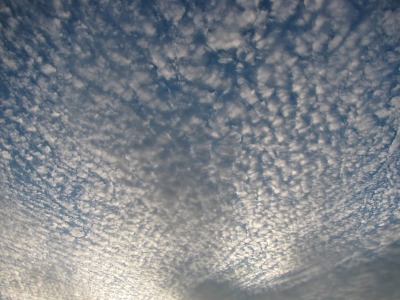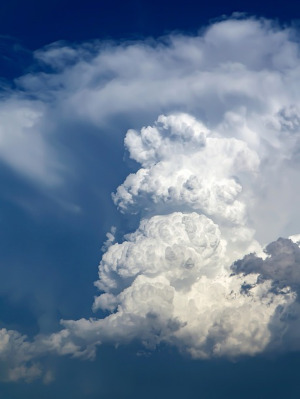There are almost 100 different types of clouds, according to the World Meteorological Organization. The differences are based on factors including shape, transparency, and arrangement. The many variations of clouds can be arranged into 10 groups depending on their general shape and position in the sky. This includes:
Low-level clouds: The clouds cumulus, stratus, and stratocumulus are low-level clouds and lie below 1,981 meters.
Middle-level clouds: The clouds altocumulus, nimbostratus, and altostratus are middle-level clouds, which form between 1,981 and 6,096 meters.
High-level clouds: The clouds cirrus, cirrocumulus, and cirrostratus are high-level clouds and form above 6,096 meters.
Cumulonimbus clouds can cover the low, middle, and upper atmospheres.
Cumulus
Cumulus clouds develop on clear and sunny days when the sun heats the ground below. They appear in the late morning, grow throughout the day, and disappear toward evening. The tops of cumulus clouds are rounded, puffy, and brilliant white when sunlit. The bottoms of cumulus clouds are flat and relatively dark.

Stratus
These clouds appear on dreary, overcast days. Stratus clouds are associated with light mist or drizzle. They hang low in the atmosphere. This cloud is flat and featureless. This uniform layer of grayish cloud resembles fog that hugs the horizon.
Stratocumulus
These clouds form when there is weak convection in the atmosphere and are seen on mostly cloudy days. Stratocumulus clouds are low, puffy, grayish, or whitish clouds that arise in patches with a blue sky visible in between. They have a dark, honeycomb appearance when viewed from underneath.
altocumulus
These are the most common clouds in the middle atmosphere and are often spotted on warm and humid mornings, particularly in the summer. Altocumulus clouds can signal thunderstorms to come later in the day and the onset of cooler temperatures. These clouds look like white or gray patches that dot the sky in large, rounded masses or clouds that align in parallel bands. Altocumulus clouds resemble the wool of sheep or the scales of mackerel fish.
Nimbostratus
These clouds are typical rain clouds. Nimbostratus clouds are visible whenever steady rain or snow is falling or is forecast to fall over a widespread area. They cover the atmosphere in a dark gray layer and can extend from the low and middle layers. Nimbostratus clouds are thick enough to block out the sun.
Altostratus
These clouds tend to develop as gray or blue-gray sheets of clouds that partially or completely cover the sky at mid-level. Even when these clouds completely cover the sky, the sun is still visible. However, not enough light shines through to cast shadows on the ground.
Cirrus
These clouds normally develop in fair weather. They can also form ahead of warm fronts and large-scale storms, so seeing cirrus clouds may indicate a storm is coming. Cirrus clouds resemble thin, white, wispy strands of hair that streak across the atmosphere. They are made up of small ice crystals rather than water droplets, as they appear at an altitude where low temperatures and low water vapor exist.
Cirrocumulus
These clouds consist of small, white patches, often arranged in rows, that are made of ice crystals and frequently resemble grains. Cirrocumulus clouds are rare and don’t last long. They are visible in winter or when it is cold but fair.

Cirrostratus
These transparent, whitish clouds veil or cover nearly the entire sky. A ring or circle of light may appear around the sun or moon. This ‘halo’ is formed by the refraction of the light on the ice crystals in the clouds. Cirrostratus clouds indicate that large amounts of moisture are present in the upper atmosphere.
Cumulonimbus
These thunderstorm clouds are one of the few that span the low, middle, and upper layers. Cumulonimbus look like cumulus clouds, except they rise into towers with bulging upper posts that resemble cauliflower. The tops of these clouds are usually flattened in the shape of a plume, with dark and hazy bottoms.

Sources:
https://www.thoughtco.com/types-of-clouds-recognize-in-the-sky-4025569
